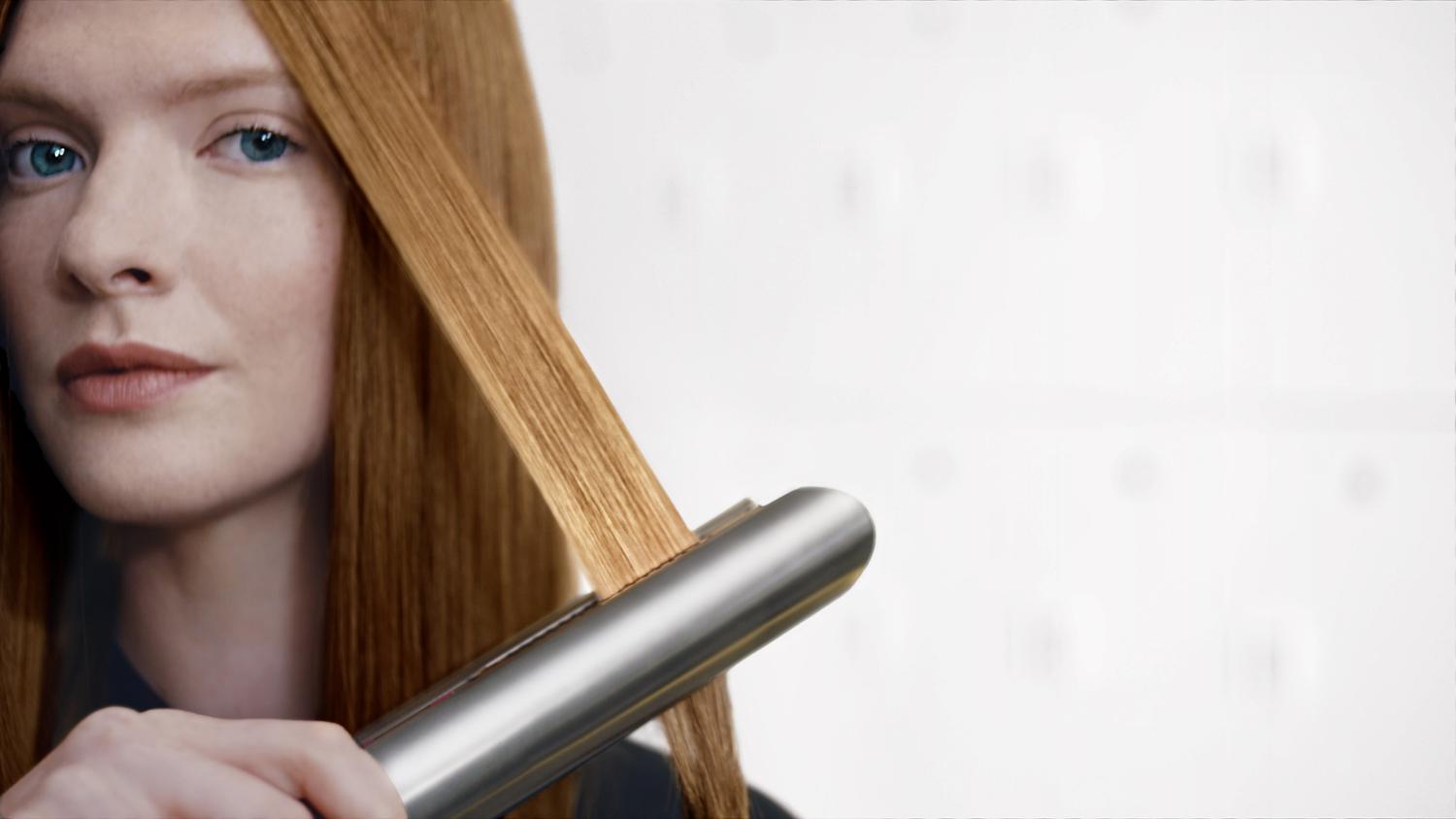
Dyson Corraleᵀᴹ Straightener: Engineered to keep hair color fresh through the seasons
-
A new hair color is a fresh way to change up a look for the season – from bright summer hues, to warm autumn tones, cool wintry highlights, or pastel spring shades. But despite the visual benefit, Dyson’s hair scientists have carried out research revealing how high heat can cause color fade and damage to the core of the hair strands.
-
"The more heat used on hair, the more significant the color fade. This is because excessive heat can damage the outer layer of hair, which allows dye to escape from hair and dulls the vibrancy of the color. The Dyson Corrale™ is the only hair straightener with flexing plate technology and the combination of its flexing plates and intelligent heat control, engineers it for less color fade due to excessive heat" - Veronica Alanis, Engineering Lead, Dyson
-
Dyson has been researching the science of style for more than a decade, investing £100m into its hair laboratories globally, and delving into the science of color fade. This has helped uncover insights that reveal how, with the right education and hair tools, damage and color fade can be controlled.
-
Four reasons for hair color fade
There are many reasons why hair color can fade, which includes the type of colorant used, the chosen color, washing frequency, UV exposure, cuticle damage and the use of high temperatures for styling.
Here we explore some of these in more detail.
UV rays
Overexposure to sun can cause hair damage. Bright sunlight can erode the vibrancy of hair color by destroying its natural melanin pigments while dye molecules can also escape more easily from damaged hair. Overexposure can also damage the keratin in hair, so it feels brittle.
UV has been shown to degrade the color molecules formed during the dyeing process. This degrading process causes the color to fade, impacting overall look and shine. Wearing a beach hat or staying in the shade is a simple way to limit UV exposure. In natural hair, UV light and temperatures above 81∘C can cause unpigmented hair such as white or grey hair to turn yellow. This change is more visible in unpigmented hair as the existence of melanin in pigmented hair will mask the change and may slow the reaction.
Chlorine
Chlorine in swimming pools can cause the hair cuticle to become damaged, increasing strand friction and the impact of mechanical damage. Copper algaecides are sometimes used to help keep swimming pools clear of algae. Those with bleached hair should take note that the copper algaecides have been shown to cause bleached hair to turn slightly green. Washing hair as soon as possible after a swim with a mild shampoo helps minimise the risk of damage.
Sea and sand
Sea water leaves hair coated in a layer of salt which increases the friction of the strands and causes damage that can lead to breakage. While salt from the sea will not cause significant chemical damage, it can dry it out slightly. Sand is an abrasive material that can wear down the cuticle layers. To avoid this, gently wash salt and sand out of hair as soon as possible.
-
-
Did you know?

The Dyson CorraleTM straightener is engineered to deliver enhanced styling for all hair types without excessive heat1
Hair coloring can weaken hair as it is a chemical treatment that can break the bonds in hair’s cortex and cuticle. Further damage can quickly set in with styling at high temperatures.
The rate of color fade depends on:
Type of color used: Permanent color formulations will last longer than temporary ones.
Color chosen: Certain colors, such as red, tend to fade more quickly as its molecule is larger than other color molecules and doesn't penetrate the cortex of the hair as other color molecules. Black and brown tend to last longer.
Washing: The dye molecules will gradually wash out of the hair, causing color to fade.
UV exposure: UV has been shown to degrade the color molecules formed during the dyeing process.
Cuticle damage: Dye molecules can escape more easily from damaged hair.
Heat: Heat temperatures may increase how quickly new color washes out of hair.
-
Getting started with your Dyson Corrale™ straightener
Explore video styling guides, useful tips, your user manual, and more.
-

-
How the Dyson Corrale™ is engineered to reduce color fade
Flexing plates
Some straighteners have solid plates. Dyson engineered the Corrale™ straightener with pioneering flexing copper plates which shape to gather hair, applying even heat and tension to hair strands in every pass and keeping them perfectly aligned. This delivers enhanced styling with half the damage1 to users, to protect against hair breakage. Through increased control provided by the patented plates, the Dyson Corrale™ straightener helps prevent color fade for color-treated hair by reducing hairs’ exposure to excessive heat.
-
Plate manufacture
Multiple alloys were tested before a complex manganese copper alloy – a mixture of copper, manganese, aluminium, iron, tin and nickel – was chosen for the patented flexing plates. This combination of materials provides the flexing plates with the optimum flexibility, strength and thermal conduction. The plates are incredibly thin and this allows them to shape and flex perfectly around hair.
Intelligent heat control
Equipped with intelligent heat control, the Dyson Corrale™ straightener has a dynamic heater system with an integrated sensor that regulates temperature 100 times per second. This technology communicates with a microprocessor which in turn controls the heating system to deliver precise, accurate heat. With three heat settings – 165°C (330°F), 185°C (365°F) and 210°C (410°F), the temperature options allow users to tailor the settings to suit their hair type, length and desired style.
Pioneering battery technology
Last but not least, the Dyson Corrale™ straightener is powered by a four-cell, lithium-ion battery, which delivers the thermal performance of a corded product – with the cord-free versatility to style anywhere, anytime. From straight locks to curly waves, the Dyson Corrale™ straightener allows the creation of different looks for various occasions throughout the seasons.
-
1Thermal damage measured by hair strength, when creating equivalent style. Tested on Corrale with flexing plates vs Corrale with solid plates.
2Exact run time depends on hair type and styling habits
Press contacts
-
USA
Emails us at USPR@Dyson.com
1330 West Fulton Street, 5th Floor, Chicago IL, 60607
-
Social media
- Twitter: @dyson
- YouTube: youtube.com/dyson
- Facebook: facebook.com/dyson
- Instagram: @Dyson
- Instagram: @dysonbeauty
- LinkedIn: Dyson
- Pinterest: Dyson Technology

.jpg?$responsive$)
